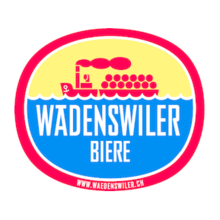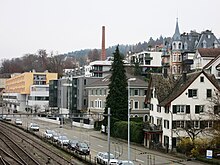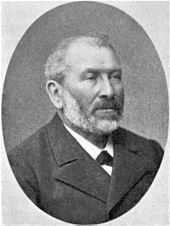Wädenswil brewery
The Wädenswil brewery in the Swiss canton of Zurich was a beer brewery in Wädenswil that was in operation from 1833 to 1990. The building of the former brewery was partially demolished in 2003. The tradition of the Wädenswil beers has been continued since 1992 by “Wädi-Brau-Huus AG”.
history
19th century
In 1826 Heinrich Rusterholz bought a property "zum green Hof" in Wädenswil , in which he had a brewery including a malt house and a vaulted cellar set up seven years later (1833). In November 1837 Heinrich Rustenholz bought land in order to be able to build an extension, another building and two more vaulted beer cellars underneath in 1840. The beer cellars were needed in order to be able to produce more lager beers and thus take into account the growing market for higher quality beers. In order to be able to finance the expansion, Heinrich Rusterholz entered into a partnership with Caspar Blattmann in 1840, but this only lasted for a short time. Caspar Blattmann left the business on October 30, 1841 and Heinrich Rusterholz was left to his own devices. In 1844 he had to file for bankruptcy. The property fell to the former partner Caspar Blattmann because Heinrich Rusterholz was in debt to him.
Who continued to operate the brewery during the takeover by Caspar Blattmann in July 1844 until June 1847 can no longer be determined. On June 8, 1847, the brewer Jakob Biber von Wädenswil leased the premises. At some point between 1844 and 1849 the brewery was moved to the so-called “Rothaus” and the former premises of the brewery (in the “zum Grünenhof” property) were converted into an apartment in 1849. Jakob Biber only managed the brewery until February 1853 and handed it over to the brewer Heinrich Rellstab, who continued the business until October 30, 1856. On October 15, 1856, the owner Caspar Blattmann sold the brewery building including the furnishings and additional land (garden, meadow and farmland) to secondary school teacher Gottlieb Naef von Hausen. The new owner entered into a partnership with his brother-in-law, the beer brewer from Oberstrass Michael Weber, and they have been running the brewery under the name "Naef & Weber" since December 30, 1856. The brewery was supplemented with a rock cellar in 1858 as the basis for production of lager. The cellar was constantly expanded in the following years.
The partnership was dissolved in 1867 and Michael Weber continued to run the business alone until his death in 1885 under the name of "Brauerei Wädenswil, Michael Weber". After a fire on April 13, 1874, he had to rebuild the company almost completely and even expanded the facility significantly until 1877. Under the leadership of Michael Weber, beer sales increased from around 1000 hectoliters when the brewery was taken over 20,000 hectoliters mark on his death. After Michael Weber's death, his wife ran the business, supported by master brewer G. Bichler, for two years until 1887. After that, the sons (Fritz and Franz) took over the business under the company name "Brauerei Wädenswil, Gebrüder Weber". In 1887 the rock cellar was connected to the business premises by a 350 meter long tunnel and in 1890 a cooling system consisting of two cooling machines was purchased. Thanks to the cooling system, the original ice cellar in the storage cellar could be converted. In the business year 1890/1891 35,000 hectoliters of beer were sold. The cooling system was expanded in 1892 and 1896.
In 1894, a shipping company using motor boats, steamers and barges was introduced in order to be able to sell the beer across Lake Zurich . An electric cable car carried the beer from the shipping hall to the ship hall, where the cargo was finally unloaded. In 1898 the production plant was electrified and the malt house was closed. Also in 1898 a new building was built for washing the barrels, the bottling plant and for making ice cream as well as for office space.
Since the demand for water had risen sharply since the cooling systems were purchased, a pumping system with four pumps ( hydraulic ram ) was built to pump water from the lake at a depth of 20 meters through two 120 meter long pipes into the pipeline network. The water was filtered through a sand filter before use. The output of the system was 30 liters of water per second, with 12 liters of used water being added to the hydraulic ram and thus used again as a driving force for pumping the water.
20th century
In the business year 1910/1911 the beer sales amounted to 106,700 hectoliters and thus represented a tripling of the sales in the past 20 years. In 1913 a mash filter (Bührle system) was purchased. In 1916, the master brewer Otto Rechenmacher, who was already employed under Michael Weber, retired. As with all Swiss breweries, sales fell considerably during the First World War and were only 29,600 hectoliters in the 1917/1918 financial year. The company was not converted into a stock corporation under the Weber brothers and was thus the only large Swiss brewery in 1922 that was still privately owned. On January 1, 1922, the "Brauerei Wädenswil" had 53 apartments for employees and workers, making it the brewery with the largest number of apartments in the canton. At that time, the “ Haldengut Brewery ” had over 40 apartments. Other breweries in the canton, on the other hand, did not want their own workers 'and employees' apartments.
After the death of Franz Weber, the heirs of Franz Weber-Hauser ran the company in 1924 as a general partnership «Brauerei Wädenswil, Weber & Cie. " further. Walter Weber joined the management as a representative of the third generation. Like his father and uncle, he was elected President of the municipal council of Wädenswil in 1931. In 1929 the mineral spring Elm was acquired and the fresh water drink Elmer Citro , which was successful in the 1930s, was brought onto the market. After a record volume of 135,692 hectoliters of beer was sold in 1931, sales initially stagnated due to the crisis and unemployment and then declined. In 1938 the general partnership was converted into a limited partnership.
When the Second World War broke out in 1939, the brewery was well equipped, as it had more than a year's demand for raw materials in stock. The war economic measures brought numerous restrictions. In September 1940 only a quarter of the raw material requirements could be bought. The retention agreement signed by the breweries enabled a fair balance between them. The difficult conditions and the increase in the beer tax reduced sales in 1943/44 to 42,000 hectoliters.
In 1952, Paul Weber, the fourth generation, took over management. In 1957, the Wädenswil brewery celebrated the "100 years in the possession of the Weber family" anniversary. In the early 1960s, beer sales were over 200,000 hectoliters.
In 1970 the limited partnership of the family brewery was converted into the joint stock company “Brauerei Wädenswil, Weber AG” and became a member of “SIBRA Holding” (Brasserie du Cardinal and Brasserie du Beauregard in Freiburg, Salmenbräu in Rheinfelden and Brasserie d'Orbe in Orbe). Cardinal beer was brewed in Wädenswil from 1973 until it closed in 1990 .
In 1992 "Wädi-Brau-Huus AG" was founded in order to continue the old Wädenswil brewing tradition. An inn with a brewery was opened on the Gessner site “di alt Fabrik”. In January 2000 the management was handed over to Christian Weber, the representative of the fifth Weber generation.
Beer ships
For the export of Wädenswil beer, in addition to the trucks, two small Lake Zurich ships were used to service the lakeside communities' beer depots located on the lakeshore. The steamship Gambrinus carried the beer on a boom to the beer depots in Lachen , Rapperswil , Männedorf and Wollishofen . This subject was also found on pub signs and beer mats . In 1966, the Wadin (named after the oldest name of the brewery "Wadinswilere") was purchased, a modern refrigerated ship . With the closure of the depot in Wollishofen, however, the well-known beer ship was no longer busy and was converted into a floating beer pool for folk festivals on the lake.
Awards
- In 2001, 2002 and 2003 the Wädenswil beer brandy won the gold medal as the best brandy in Europe at the Destillata in Vienna .
- In 2010 four types of beer from Wädenswil won medals in the Swiss Beer of the Year competition : gold for the best wheat beer in Switzerland, silver for the light, dark and single malt beer.
Web links
- Official website of Wädi-Brau-Huus AG
- Anniversary brochure Wädenswiler and their beers 1826–2002 (PDF)
Individual evidence
- ↑ a b c d e f Fritz Schoellhorn , The brewing trade and the breweries of the Canton of Zurich . Buchdruckerei Winterthur vorm. G. Binkert, Winterthur, 1922
- ^ Karl Thöne, Swiss beer book . Fachverband Schweizer Wirteverband Zürich, 1987, ISBN 3-85898-007-2
- ↑ History: Wädenswiler and their beers
- ↑ Roger Bataillard: People at the lake - The 3rd life of the Wadin. In: Seesicht 4/2009. pp. 18-19



